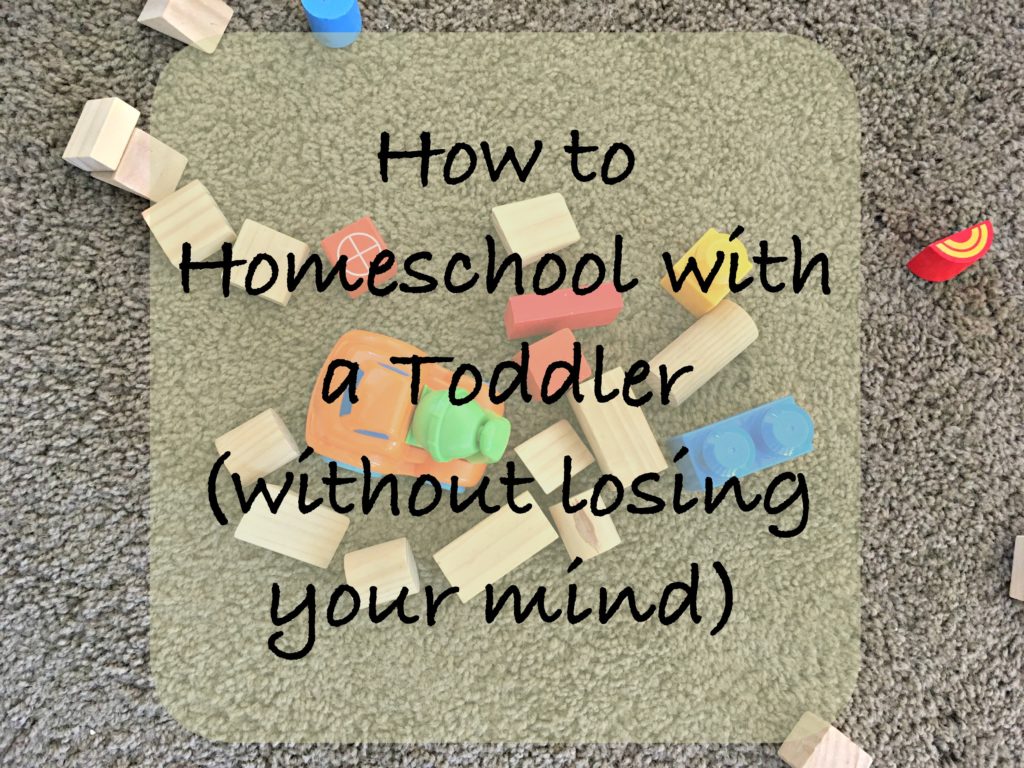Jerry Seinfeld once said, “Having a two-year-old (toddler) is like having a blender with no lid.”
I agree, Jerry. I agree.
So what do we do? As homeschool moms, how can we make sure our big kids are receiving the education they need and simultaneously keep the toddler from playing in the toilet?
In our 15+ years of homeschooling, I’ve survived 10 toddlers (so far). But I’ll be honest, this 11th one is threatening to do me in! So here I am reminding myself of all the helpful things I’ve learned over the years to not only survive the toddler years, but to THRIVE in them!
For clarity’s sake, I’m defining toddlerhood as the years between 12 and 36 months. In our case, he’s 13-months old. I hope the ideas I share here will help you to thrive through the toddler years as well.
Nap Time
Sleep when the baby sleeps? No way! School when the baby sleeps!
I know as a mom I’d really rather be relaxing and enjoying some peace and quiet when the toddler sleeps, but I also realize this is a great opportunity to connect with my big kids–academically and emotionally–with fewer interruptions.
 We are fortunate in that our little guy still naps in the mornings and usually naps in the afternoons too. We use the morning nap time for group lessons and read-alouds. Afternoon nap time isn’t guaranteed, so we usually have less structured activities. The kids may watch an educational video or bring out the Legos (not allowed when the toddler is awake) or play outside.
We are fortunate in that our little guy still naps in the mornings and usually naps in the afternoons too. We use the morning nap time for group lessons and read-alouds. Afternoon nap time isn’t guaranteed, so we usually have less structured activities. The kids may watch an educational video or bring out the Legos (not allowed when the toddler is awake) or play outside.
Team Work
I try to instill in my kids that as a family, we all work together for the good of the family. We’re a team, and we want the team to succeed. This sense of teamwork applies to meal prep and clean up, home maintenance and cleaning, as well as homeschooling.
Before I share the details of this tip, I feel that I should make something clear. I DO believe that children should be expected to help with the care of their siblings (teamwork). I do NOT, however, believe that the majority of child-rearing tasks should be assigned to the children.
With that said, each of the bigger kids (ages 10, 12, and 13) gets 20-minutes of toddler time each morning. After breakfast, we’re all finishing up our morning routines and getting ready to start our school day. While I work one-on-one with AG7, the big kids are spending 20 minutes each playing with the toddler. They spend the other 40 minutes working on independent school subjects.
This gives me an entire hour of mostly uninterrupted time to work on reading and math with the 2nd grader. And it gives the big kids some one-on-one time to bond with the youngest member of the family.
Include Them
Whenever possible, include the toddler in what you’re doing. I know this isn’t always the easiest way to get school done, but sometimes it’s necessary. While ours is only 13-months old, inclusion means mostly that he’s in the same room with us. He’ll do more as he matures and his attention span increases.
If your toddler is busy like ours, I suggest confining him as best you can. But don’t ignore him. After all, he’s part of the family too and including him is really training him to be a part of our homeschool.
We use a play pen in the school room daily. He looks at board books while he listens to us read. He attempts to sing when we sing, and he adds his own commentary to every read aloud we share.
Our boy enjoys playing with big duplo blocks, and we have a play rug on the floor where he likes to “drive” his toy cars. And he’s always welcome to sit in someone’s lap. And of course, my hip is always an option.
Cheerios on a high chair tray can be a great diversion as well. When he’s a little older, he can have play-doh or crayons and paper.
Be Consistent
This little tip is helpful in so many different areas of child training. Kids thrive on routine. It gives them a sense of security and confidence. We try to stick with a regular daily routine as much as possible. Our little guy is not the only one that behaves better when we keep our day in order.
This is not to say that you can’t change things up from time to time or that you can never leave your house. Not at all! But sticking to consistent patterns in your day will have a positive impact on toddler behavior. Have you met a toddler that wasn’t fed at the usual time or one that missed his nap? Then, you know what I mean. It happens to all of us, and it’s okay. But it shouldn’t be “the norm”.
Be Flexible
In all of child-rearing, learning to be flexible is key to survival, Moms! As much as I would love to follow a rigid schedule where school subjects begin and end at exact times, life happens. You’re just going to have to learn to “go with the flow”, because poopy diapers always happen at the most inconvenient time. It’s true!
Keeping a positive attitude in spite of all of toddler-life’s unpredictability is what will be the determining factor in whether you and I simply survive or THRIVE through the toddler years.
Hang in there, Moms. You can do it!
So what about you? Have you successfully homeschooled with a toddler? Are you in the thick of it now? What tips would you share? I’d love to hear your thoughts in the comments below.



Even though we do not have a toddler your post spoke to me, because we too teach to think of the greater good of the family. Age appropriate chores are required and expected to be completed to the best of their ability. I also feel these strategies can be used with younger (4-7) siblings, especially when doing group related learning that may be slightly over their heads.
Your tip to “go with the flow” applies to every angle of homeschooling LOL. I’ve learned that sometimes you’re not getting through that particular subject or assignment the way you wanted. So, sometimes you just have to step back, breathe, and “roll with the punches”!
I agree a lot of these ideas can be applied to other homeschool situations. I’ve often paired up an older child to read to/with a younger or to practice math facts or letter recognition, etc.